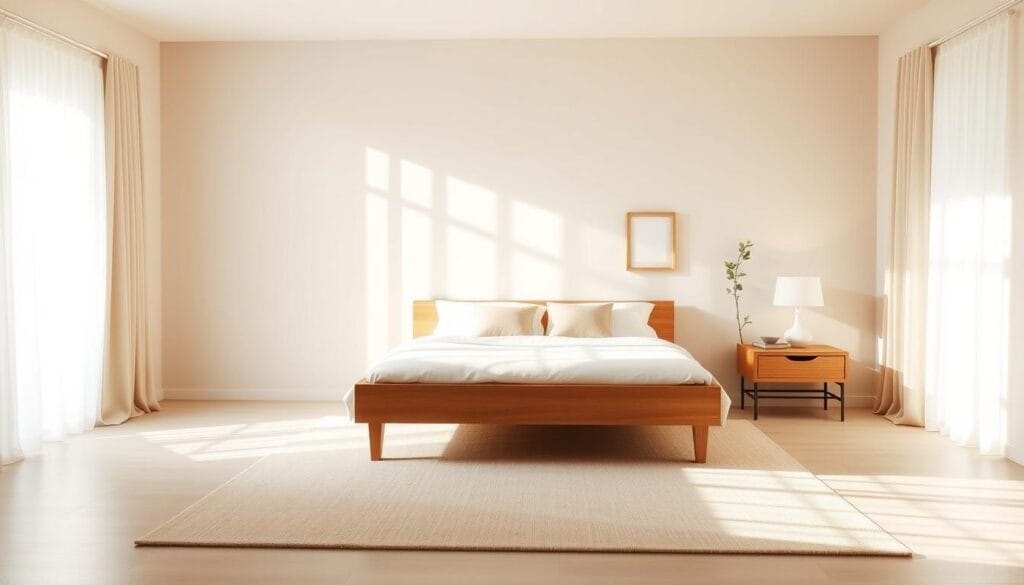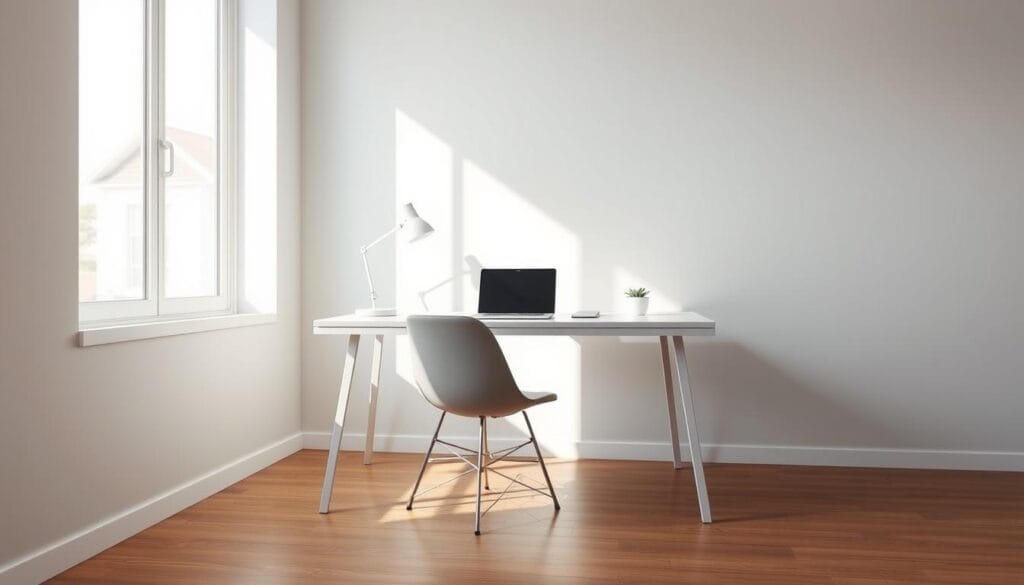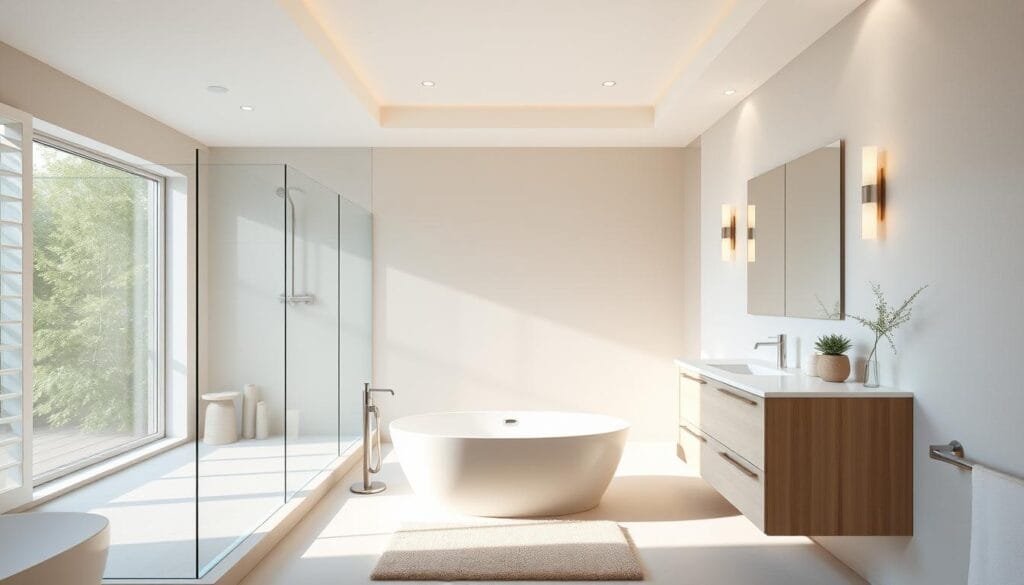Do you remember walking into a hotel room and feeling instantly calm and at ease? That’s what minimalist bedroom design does. It turns your room into a peaceful retreat. And it doesn’t mean your room will lack warmth or character. It’s about choosing each piece carefully for peace and comfort.
Think about coming home tired and finding your bedroom inviting you to rest. That’s the magic of minimalist design. It values quality and puts a lot of thought into every detail such as colors and lights. This creates a calming environment.
Looking at the minimalist bedrooms on Architectural Digest, we see how certain textures and materials can make a room cozy. Adding natural touches and clever storage makes your room stylish and comforting. The vibe is always welcoming and deeply personal.
If you want to bring minimalist beauty to any room, big or small, these ideas will guide you. Include minimal decorations like floating beds, light grays, and sheer curtains. They help make your room a stress-free sanctuary that feels perfect.
Starting this minimalist journey means decluttering your room and mind. Let’s explore these design tips to make your room a sanctuary of simplicity.
For more tips on minimalist bedroom design, visit Architectural Digest. Also, see how colors can enhance your room here.
Understanding Minimalism in Bedroom Design
“Less is more” is key in modern minimalist bedroom design. It focuses on simplicity and removing what you don’t need. This style makes the room look better and helps create a calm, focused feeling.
The Philosophy Behind Minimalism
Choosing each item with purpose is at the heart of minimalist bedroom decor. It takes cues from feng shui and simple living ideas like hygge and lagom. These principles aim to improve well-being by living simply.
Using soft colors and natural materials can make the room feel peaceful and connected to nature.
Benefits of a Minimalist Bedroom
A minimalist bedroom has lots of perks. It offers a peaceful space ideal for sleep and relaxation. Plus, less stuff means you have to clean less often, making it easy to keep things tidy.
The clean and simple look of these bedrooms is also very appealing to many people nowadays.
- Calming atmosphere: Neutral tones and minimal decor foster relaxation.
- Less maintenance: Fewer items mean less cleaning and upkeep.
- Aesthetic appeal: Simple, clean lines create an inviting space.
For more tips on creating a minimalist bedroom, check out Nourishing Minimalism.
Choosing the Right Color Palette
Choosing the right color palette for your minimalist bedroom is key. It makes the space look and feel inviting and calm. Most homeowners prefer neutral colors like whites, grays, and beiges. These shades are popular in many minimalist bedrooms. But picking the best colors for you can be tricky.

Popular Color Schemes for Minimalist Bedrooms
In a minimalist bedroom, the goal is to create a calming feel with soft and muted shades. Most interior designers suggest using neutral bases such as whites and grays. These colors make rooms feel open and airy. Earthy tones like taupe and greige bring warmth and relaxation, liked by many.
If you want to add color, go for soft blues and greens. They bring a sense of calm and rest. Nearly 80% of minimalist designs use at least one accent color. This adds interest but keeps things simple. Indeed, light and calming colors can make your minimalist space even more appealing.
How Color Affects Mood
Choosing your bedroom colors affects more than just how it looks; it changes how you feel. Soft blues and greens create a peaceful environment, perfect for rest. Many designers recommend these colors for bedrooms to help people relax and sleep better. Light grays and whites can make a room feel bigger and more open.
Add a bit of drama with saturated jewel tones in small doses. They work well for accent walls or bedding, adding elegance while keeping things simple. Color blocking can also highlight room features, making the space unique. This technique is used by 30% of homeowners.
The perfect color scheme can transform your minimalist bedroom into a peaceful retreat. By carefully choosing minimalist and calming colors, you’ll have a space that’s not just beautiful, but soul-soothing as well.
Selecting Essential Furniture Pieces
When picking minimalist bedroom furniture, focus on both looks and use. Your bed is the main part of the bedroom. Choose one that’s simple yet stylish, like the Sloane King Bed made from American walnut.
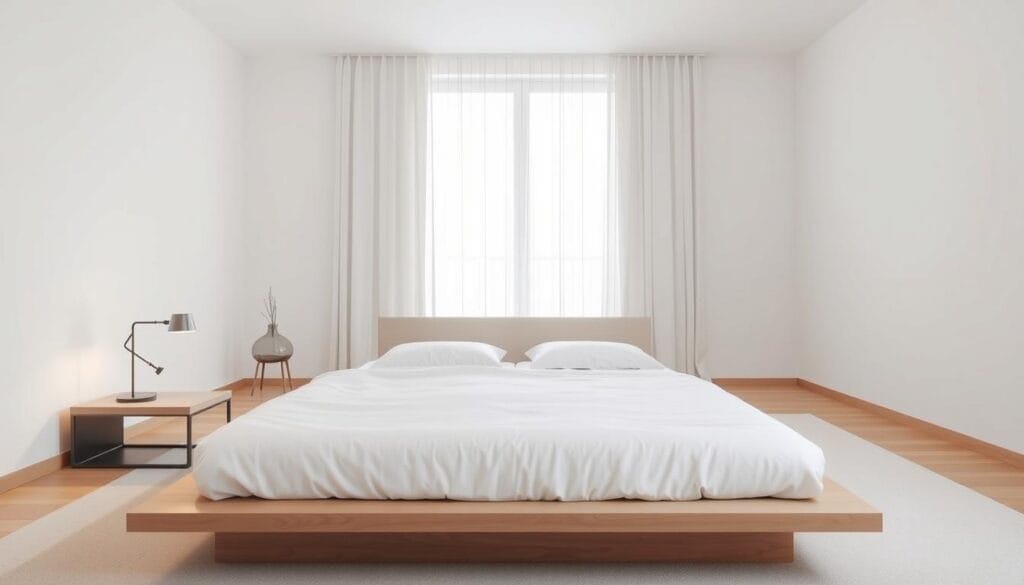
Key Furniture for a Functional Space
Putting furniture in the right spot is key to using space well and keeping things flowing. Important pieces include:
- Bed: A minimalist bed frame with clean lines and simple design enhances serenity.
- Nightstands: Compact with built-in storage like drawers or shelves.
- Dressers: Functional storage and display areas that can be customized.
- Wardrobes: Appropriately sized, focusing on neutral colors and clean lines.
- Mirrors: Enhance illumination and create an illusion of space.
- Floating desks: Free up floor space while providing necessary functionality.
- Seating: Armless chairs and ottomans that complement the minimalist look.
Multi-Functional Furniture Options
Choosing bedroom furniture that serves multiple purposes is smart. It saves space and fits the minimalist style. Beds with drawers help avoid clutter and keep the room calm and open. Extendable side tables and nesting coffee tables offer flexibility and ease. Also, lights like LEDs improve the mood and are energy-saving, matching minimalist ideas of being simple and practical.
| Furniture Piece | Functionality | Minimalist Feature |
|---|---|---|
| Bed | Primary sleeping area with storage | Simple lines, built-in drawers |
| Nightstand | Storage and display | Compact, clean design |
| Dresser | Storage and display | Neutral colors, customizable |
| Wardrobe | Clothing and accessory storage | Appropriately sized, neutral |
| Mirror | Enhance light and space | Reflective, simple frame |
| Floating Desk | Work and study space | Space-saving, minimalist construction |
| Armless Chair | Seating | Versatile, minimalist style |
Incorporating Natural Light
Adding natural light greatly changes how a minimalist bedroom looks and feels. It not only makes the room look bigger but also gives it a light, welcoming atmosphere. Let’s look at ways to bring in more daylight and the role of window coverings.
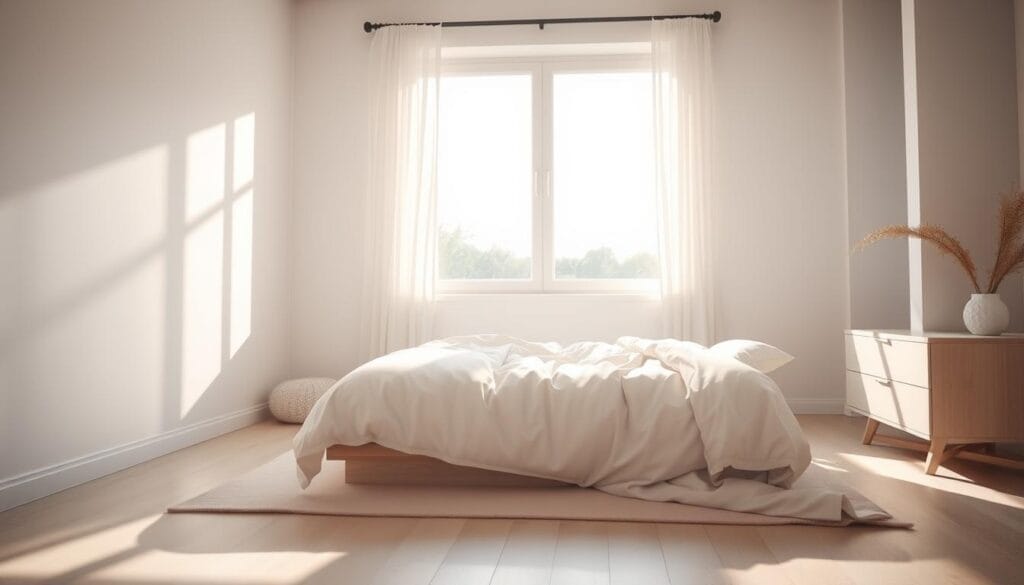
Strategies for Maximizing Daylight
To get more natural light, it helps to think about where windows go and how to use shiny surfaces. Windows that face south get the most sunshine, boosting light by up to 30%. East-facing windows catch the morning sun, and west-facing ones are great for evening glow. But, it’s key to watch out for too much glare.
Choosing light colors, like soft pastels or beiges, can bounce back a lot more light, up to 80% more than dark colors. Shiny or semi-shiny surfaces can make a room 50% brighter. Adding mirrors and using glass decor can spread light around. This makes spaces feel bigger and brighter by up to 40%.
Importance of Window Treatments
When boosting natural light in bedrooms, picking simple window coverings is essential. Light and somewhat see-through curtains strike a good balance. They let in lots of natural light while protecting privacy and blocking UV rays. Sheer curtains are good for keeping the room bright but safe from harmful sun.
Using motorized blinds or curtains can improve how you manage daylight, possibly enhancing light use by 60%. This choice not only makes your room look better but also saves energy. Plus, being in well-lit spaces can make you feel better and work better, with a possible 20% increase in productivity.
Textures and Materials in Minimalism
Adding different textures in a minimalist bedroom makes it warm and deep. Soft fabrics like linens and wools go well with hard surfaces such as wood and metal. This mix creates a stylish look. Sustainability is key in choosing materials. It makes the room look good and helps the environment.

How to Mix Textures Effectively
Mixing textures can make a minimalist bedroom cozy and welcoming. You should use a variety of materials. For example, tweed, boucle, velvet, and silk all add interest. A wool rug on top of a sisal one makes the room feel softer and more inviting.
Walls with texture, like wood or textured paint, change the room’s feel. Furniture covered in thick fabrics and accessories with texture also add to the feel. These details make the space more interesting and enjoyable.
- Tweed, boucle, velvet, silk, linen, leather
- Wood tones, metal, travertine, marble
- Textured furnishings: sofas, chairs, tables
- Layered rugs: wool over sisal or jute
Choosing Sustainable Materials
Using sustainable materials like bamboo, reclaimed wood, and organic cotton is good for the planet. They also keep the room simple and beautiful. Design and Dwelling shows off these materials. They help you pick eco-friendly options.
Bamboo is durable and grows back quickly. Reclaimed wood adds a touch of history. Organic cotton is soft and doesn’t harm the environment. These materials show you care about nature. They make your bedroom peaceful and bring an earthy feel.
| Material | Properties | Example Uses |
|---|---|---|
| Bamboo | Renewable, strong | Furniture, flooring |
| Reclaimed Wood | Unique, eco-friendly | Furniture, accent walls |
| Organic Cotton | Soft, breathable | Bed linens, cushions |
Optimizing Space with Smart Storage
In our search for a calm and functional bedroom, smart storage is key. This is especially true if your space is small. We’ll explore some top tips for blending practical storage with a minimalist look.
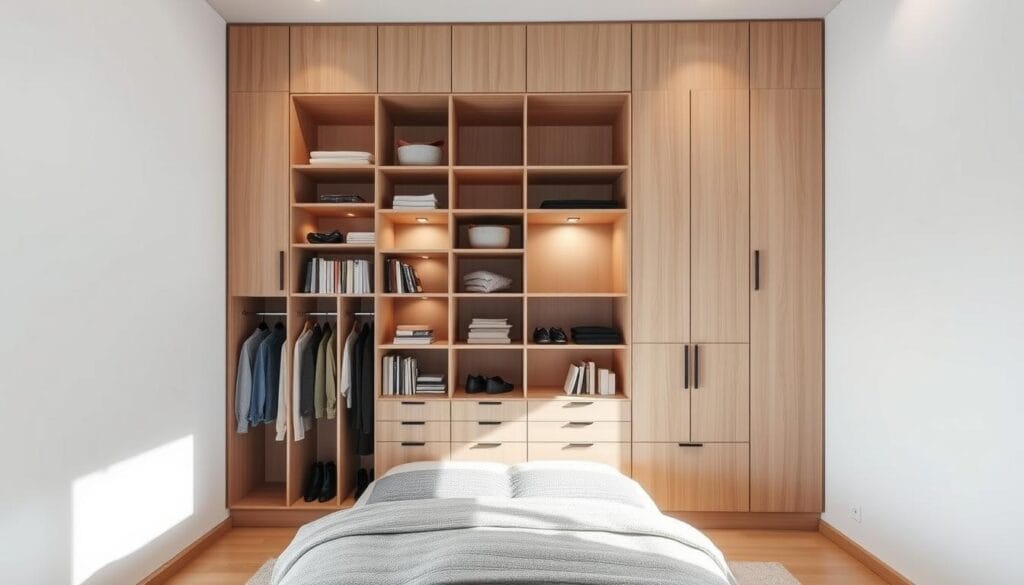
Creative Storage Solutions for Small Bedrooms
Adding multifunctional furniture is a smart move. Items like fold-down desks save space and are useful. Also, try under-bed storage to hide things away and keep your room looking neat.
Mount shelves and hooks on walls to save floor space. This works well in tight bedrooms. For items like skis, utilizing wall space is both creative and smart.
Consider adding seating with storage in nooks or beneath stairs. It’s important that every item has its own spot. This follows the ‘a place for everything’ philosophy.
The Role of Decluttering
To keep a minimalist bedroom looking great, decluttering is a must. These spaces are all about simplicity. So, getting rid of items you don’t need is essential.
Adding baskets on shelves helps keep things organized yet out of sight. Using versatile storage like baskets keeps the room looking clean. This helps create a peaceful, clutter-free space where you can relax.
Let’s use these ideas to make our bedrooms minimalist havens! 🌟
Lighting Choices for a Minimalist Bedroom
In minimalist bedroom lighting, keep things simple and useful. The right lights improve the mood and make your space work better. Think about combining ambient, task, and accent lights that fit your minimalist style. Let’s look at different lights and how to layer them for a welcoming mood.
Types of Lighting Fixtures to Consider
Choose simple but striking fixtures for a minimalist bedroom. Think about low-profile ceiling lights, sleek wall sconces, or stylish floor lamps. Cove lighting is a good choice for a soft glow that lifts the room while keeping it simple. Minimalist chandeliers or simple table lamps with natural wood add focus without clutter. They keep the room feeling calm and inviting.
Layering Light for Atmosphere
Using different lights together is key for a comfortable and flexible space. Begin with ambient light to light up the room. Add task lights in places where you need bright light for reading or other activities. Accent lights bring attention to the room’s design or make cozy spots. With dimmable lights, you can change the light level to fit the time of day or mood, turning your bedroom into a peaceful escape.
Pick and arrange your lights with care to add to the minimalist look, making sure they are useful and pretty. Whether you like clean-lined fixtures or ones with wood accents, your lighting choice will make your minimalist bedroom a calm and lovely place.

